Periyar Tiger Reserve, Kerala
-Text and Photographs
Dr.Susan Sharma, Founder, IndianWildlifeClub.com
(Continued from last month)
Day 2 saw us getting ready for the much anticipated trek. PTR has a cool and humid climate with comparatively high rainfall. April-May are the hottest and December-January the coolest. Rainy season had just got over and
the climate was pleasant.
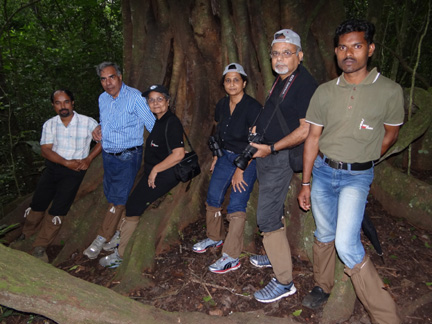
Readyfor trail
Sajeev advised that we spray a good amount of Dettol on our sox and pants to dissuade leeches. And that came out to be an excellent tip.
Rajkumar, our guide started explaining the forest types in PTR. Seven types of vegetation have been identified from Periyar Tiger Reserve, of which evergreen and semi evergreen forests form the major portion. Besides these marshy grasslands and montane
grassland sholas form extremely valuable micro ecosystems.
A bamboo raft carried us to the dense forest.
The Reserve is the only known home for several endemic species such as Habenaria periyarenesis (a ground orchid), Mucuna pruriens thekkadiancis (a leguminous climber) and Syzygium periyarensis (a tree). Flora considered previously extinct/endangered have
been reported from PTR thanks to the research and impact monitoring component of the India Eco development Project. The Aristolachia climber which is the food plant for the Southern Birdwing Butterfly, looked almost like a pitcher plant.
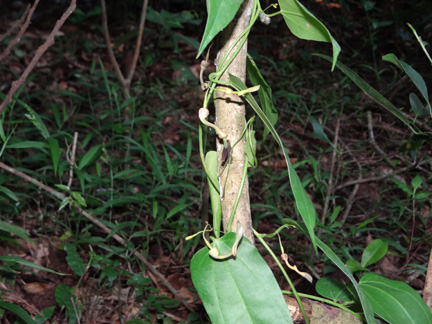
Aristolachia
The sights and sounds of the Forest soon engaged all of us. What is that bird? What sound is that? Whispers from all of us made Rajkumar take charge with Sajeev pointing out flora and trees which one would not have paid attention to otherwise. Rajkumar
borrowed my camera and came back with a shot of the horse shoe bat inside a tree cavity. This insectivorous bat is a forest pest controller, he explained.
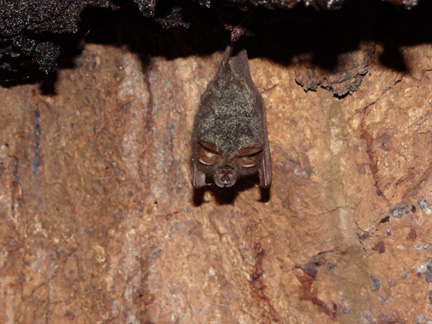
horseshoebat
The PTR brochure listed 63 species of mammals, 323 species of birds, 44 species of reptiles, 28 species of amphibians, 38 species of fishes and 160 species of butterflies. Sure enough, this Forest is teeming with life and soon our cameras started clicking.
Sajeev and Rajkumar would announce the names of birds, butterflies, amphibians, reptiles or a tree which caught our attention. They brought our attention to a dried skull of a sambar on the ground, a still dripping with honey beehive, which was lying on
the ground; the cut in a tree trunk, which Sajeev explained, is how tribals take honey out. They would cut away the honey filled portion but leave most of the bee hive with bees intact so that they can make more honey.
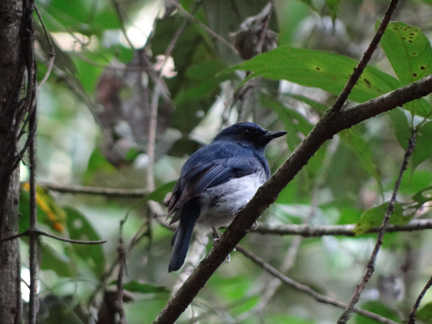
whitebellied blue flycatcher
The bicoloured frog or Malabar frog seemed to be popping out of many places. As we approached the lake bank, the black tadpoles of the frog could be seen in shallow waters forming schools of tadpoles to hunt in the slow moving stream. Despite their abundance
here, I was surprised to learn that this frog is Near Threatened(IUCN)
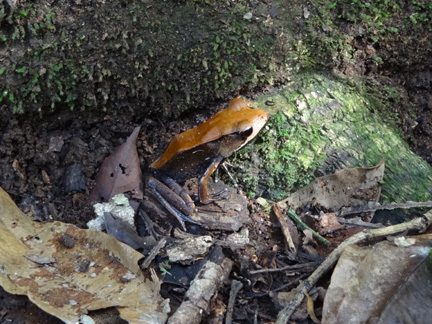
Bicolored frog
The sudden appearance of a Grey Hornbill in the canopy set our cameras rolling despite bad light. Stray langurs here and there reminded us that we may run into that elusive creature -the lion tailed macaque- the endangered endemic primate of Western
Ghats. Giant squirrels appeared, always munching on food! These squirrels could be seen en-route our road trip to PTR as well.
Sajeev explained that the faunal diversity in PTR is unparalleled. Elephant, Gaur, Tiger, Panther, Sambar, Barking Deer, Wild Boar, Sloth Bear, Nilgiri Langur, Lion-tailed macaque, Otter, Malabar Giant Squirrel, Wild Dog etc are the major mammals. Fourteen
endemic species of birds have been reported from Southern Western Ghats including the Malabar Grey Hornbill, the Nilgiri wood pigeon, Blue winged parakeet, Crimson throated barbet, Rufous babbler and White breasted laughing thrush.
Four fresh water fishes are endemic to the Reserve. But introduced species like Tilapia are abundant in the Lake.
Around 58 villages are situated on the fringes of the Tiger Reserve. It is estimated that around 2.25 lakhs of people live within the 2km radius of the Tiger Reserve. These communities have partial or complete dependency on the forests. About 22 estates
situated along the boundary of Tamil Nadu harbour nearly 3000 labourers, with more than 1000 of them having been identified as dependent on the Tiger Reserve for various purposes. To empower these communities and to reduce the dependencies on forests, various
Ecodevelopment activities were launched in mid 1990's. Pure wild honey and allied products, lemon grass oil, eucalyptus oil, sandal wood sticks, pepper, frankincense are some of the products you can buy at the Vanashree shops.
The commitment of Rajkumar, our guide, and the eagerness of a trainee who kept on taking down notes during the trek- are experiences all four of us will never forget. This commitment of individuals is what makes PTR a special Forest. Under the Eco development
program, many tribals and even ex-poachers have been trained to become guides. These guides engage in forest protection on a full time basis. Rajkumar spoke flawless English, was truly knowledgeable about the forest, its moods, flora and fauna. His pride
and enthusiasm in the denizens of PTR is bound to rub off on any tourist. Education officers train and up skill local communities, helping them develop a stake in Forest protection. Trekking in PTR was, for us, experiencing conservation at grassroots.